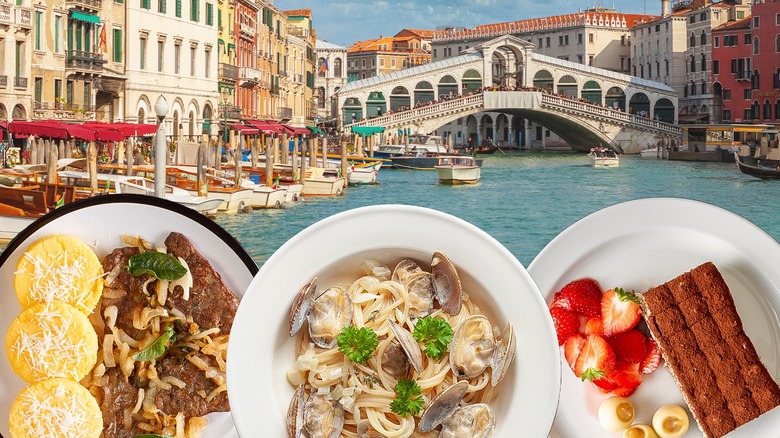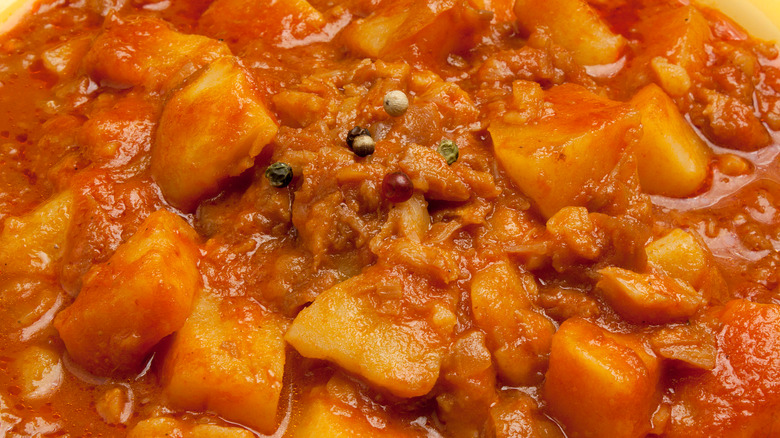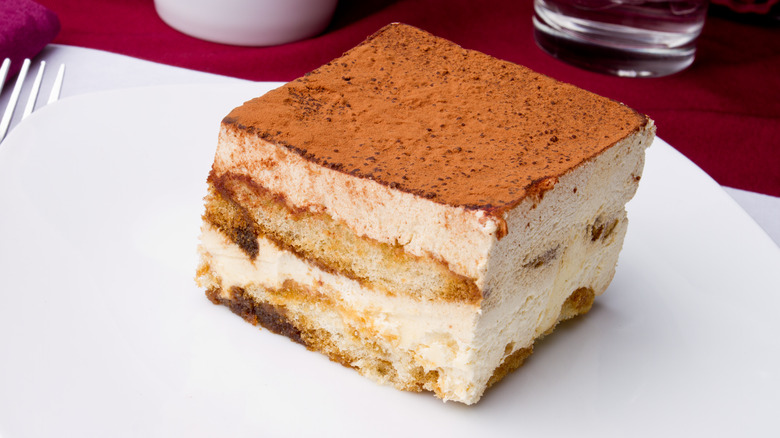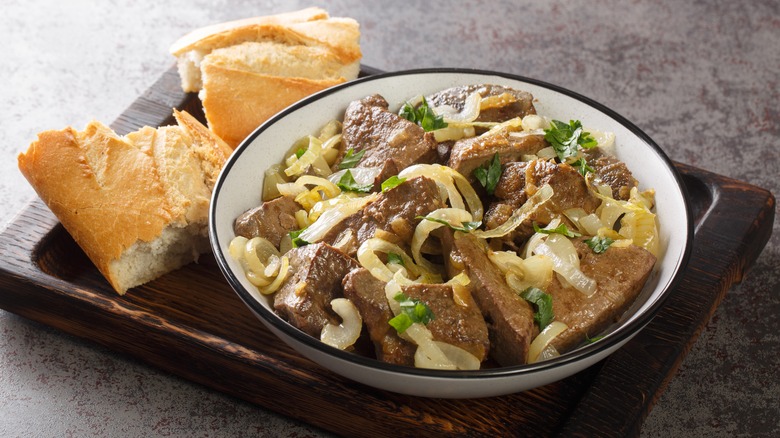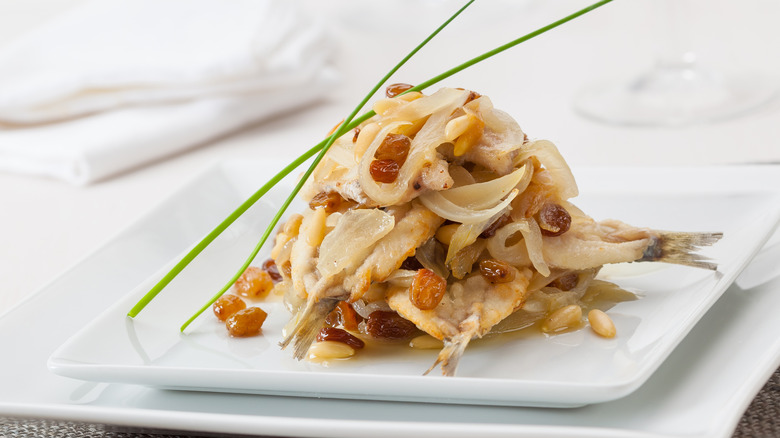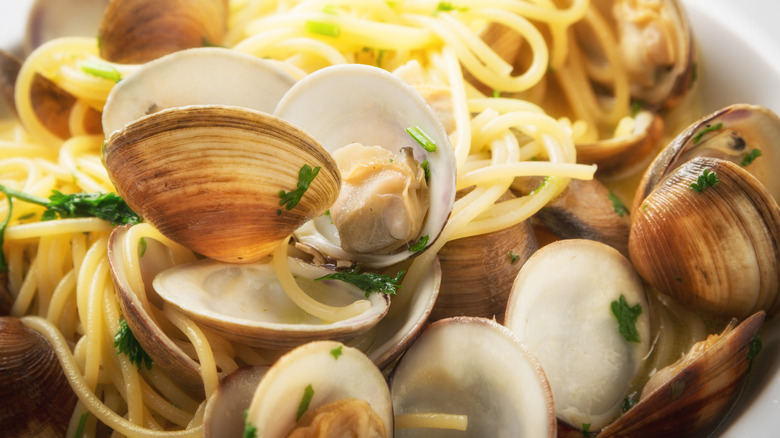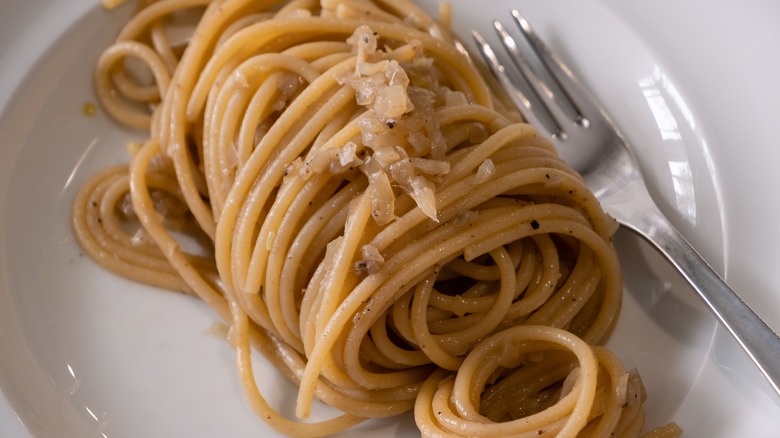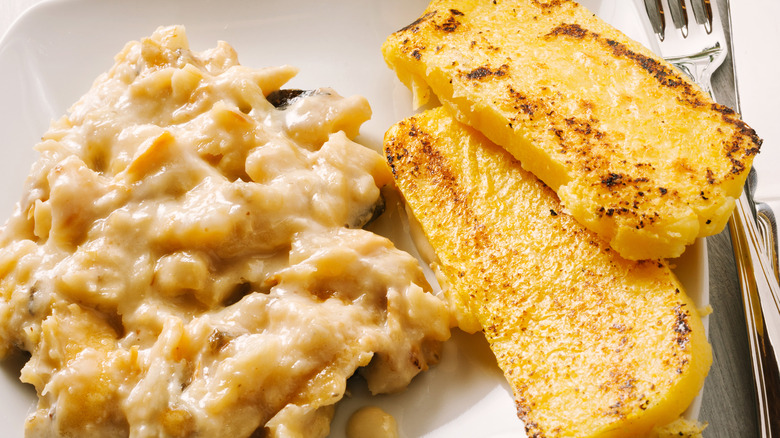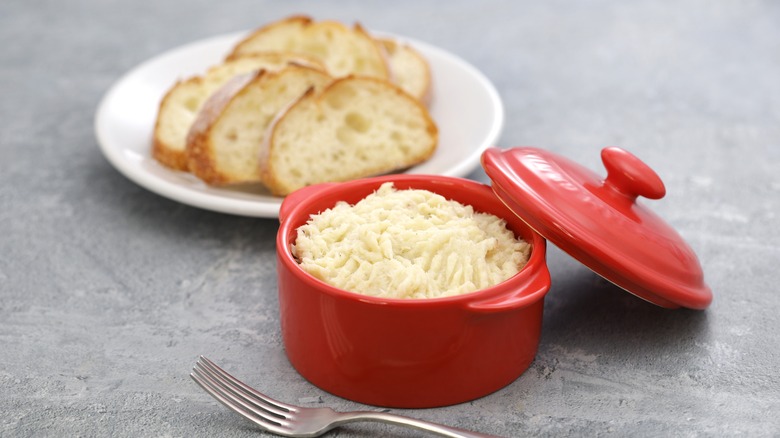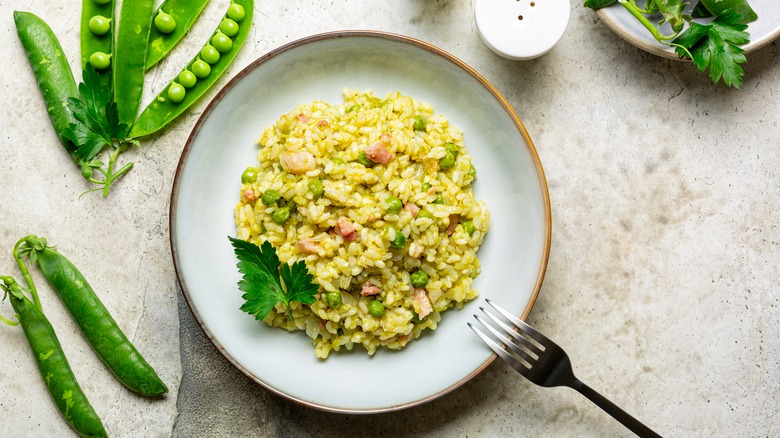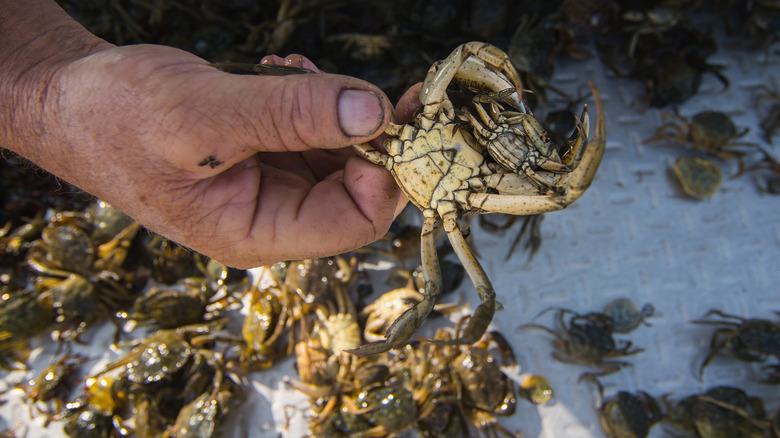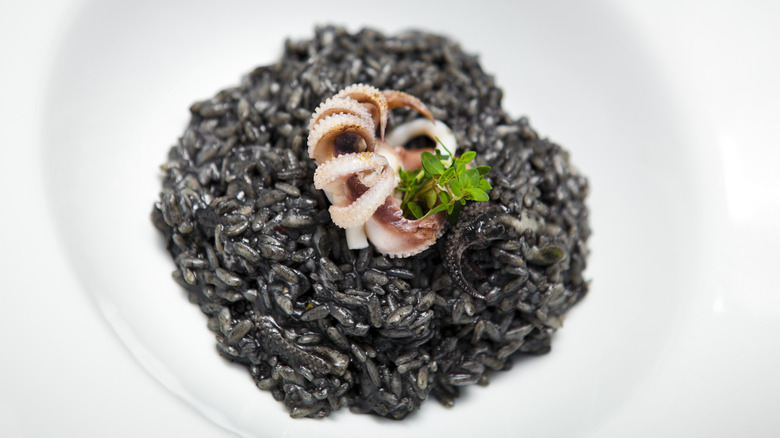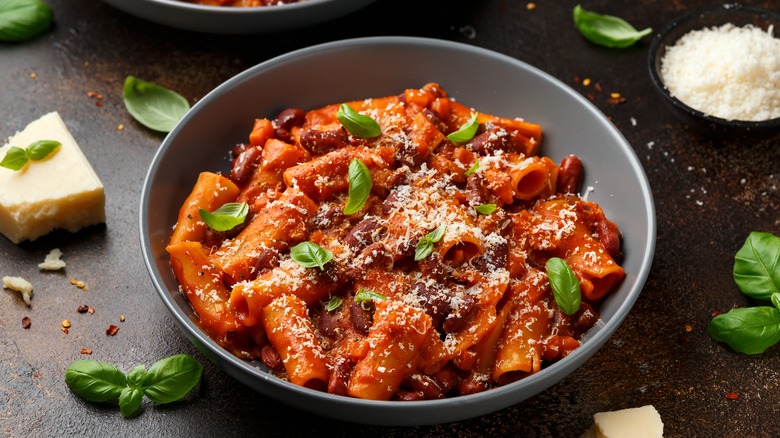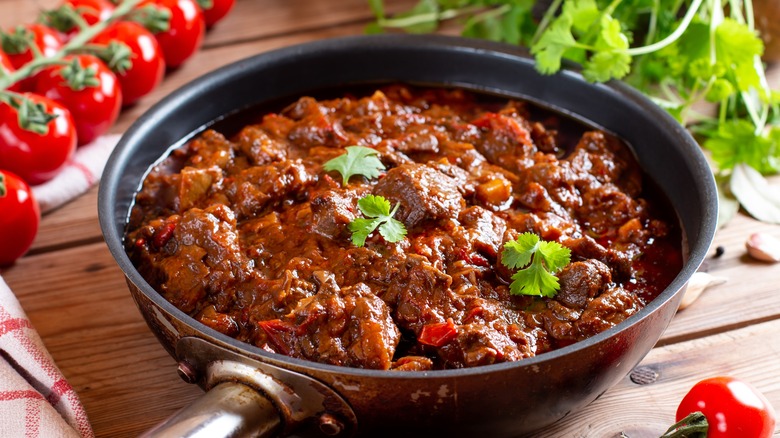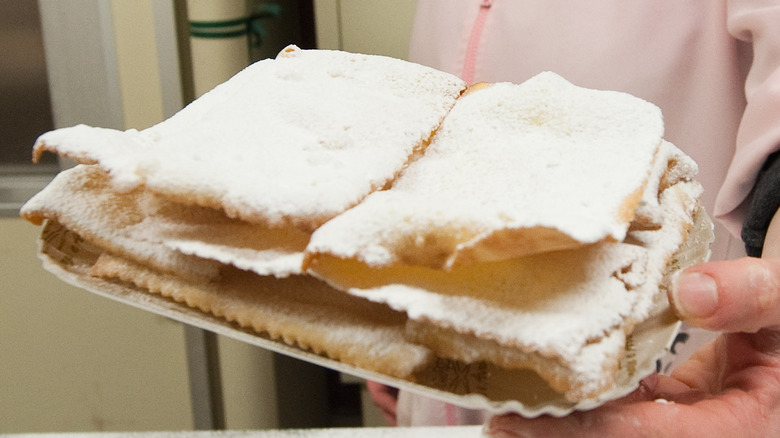The 15 Classic Dishes In And Around Venice You Should Try, According To A Local
Each region of Italy has its own, distinct cuisine, and the Veneto region in northeastern Italy is no different. Veneto, and its main city of Venice, have a food culture that is heavily influenced by its location on the Adriatic Sea. Dishes like sarde in saor (marinated sardines) and baccalà mantecato (creamed cod) showcase the Venetian way of taking fresh fish straight out of the sea and using it to make something new, intricate, and, of course, tasty.
The inland region, where I grew up, features fertile plains and rolling hills that host a diverse array of agricultural products. There's plentiful produce, including radicchio and beans, as well as polenta, a grits-like side made with cornmeal that's often served as an accompaniment to stewed meats and melted cheeses. This bounty is accompanied by a generous selection of regional wines, like bubbly prosecco or a full-bodied Amarone.
Reading a menu at a Venetian restaurant can be a little daunting, especially if you're visiting the region for the first time. Many traditional dishes are not commonly found in Italian restaurants in America — and you certainly won't find anything like them at Olive Garden. So I've put together a list of some of the main dishes you should know about so you can make an informed decision about what to order on your next visit.
Polenta e baccalà
Baccalà is what the people of Veneto call salted and dried cod, a protein that can be prepared in several different ways. In the hills north of Venice, you are most likely to find baccalà that's been dipped in flour and lightly pan-fried before being incorporated into a tomato-based sauce.
This dish is often referred to as baccalà in umido; the "in umido" means "stewed with polenta." If you make this recipe at home, make sure you serve the polenta creamy, fresh, and steaming hot straight out of the pot. The polenta is supposed to be somewhat gooey and freshly-made because it needs to absorb the sauces; day old-grilled polenta just won't do.
You can find high-quality salt cod at some grocery stores or specialty Italian markets, and some vendors will even ship it straight to your door so you can enjoy this fish outside of Veneto.
Tiramisu
Tiramisu, which literally means "pick-me-up," might be one of the most famous Italian desserts. However, not a lot of people know that it was invented smack dab in the middle of Veneto, in the relatively small and little-known city of Treviso.The date was 1800, and as legend has it, it was invented by a mistress at a house of pleasure and was considered to be a sort of aphrodisiac.
Whether that's true or not, this dessert is certainly a pleasure to consume. The mixture of egg yolks, sugar, mascarpone, heavy cream, ladyfingers, cocoa powder, and coffee provides the ideal balance of sweet and bitter flavors that might just be what one needs to awaken all sorts of senses.
Classic tiramisu has come a long way from its Veneto roots. The dessert can be found in various iterations, including a popular matcha version, where matcha green tea infuses the ladyfingers and is dusted on top of the cake before serving.
Fegato alla Veneziana
Fegato alla Veneziana gives a whole new meaning to the phrase, "What am, I chopped liver?" If you get to try this chopped liver dish, rather, you should consider yourself lucky. It's one that everyone passing through Venice should try at least once.
This Italian version of classic liver and onions mimics almost the exact same ingredients as the American preparation, including butter, plenty of yellow onions, beef liver, beef stock, and flour, which together creates a rich gravy that goes exceptionally well with mashed potatoes. Liver may have a bad reputation among modern palates, but that may be because it's so easy to overcook. So if you plan on trying this recipe at home, try to avoid leaving the liver in the pan for too long, or it will become as chewy and unappetizing as when your grandma tried to make it. You should also take care to choose good quality liver and opt for pieces with an intense red-brown color.
Sarde in saor
Sarde in saor is a typical Venetian antipasto is served at any time of the year. But it's especially popular around the Christmas holiday. You can also find it served with other traditional cicchetti, small snacks usually served with an aperitif, like a spritz. It is made by combining small, fried sardines with "saor," which is a condiment composed of onions cooked in vinegar with pine nuts and raisins. Not only does this delightfully sour sauce flavor the fish, but it also helps preserve it, which is how the dish first came to be.
Back in the day, this food was contrived by Venetian sailors who wanted to preserve their sardines for long sea voyages. In fact, it is best to enjoy sarde in saor after the flavors have been allowed to meld for a whole day. The simplicity of this dish makes it possible to also prepare it at home as an appetizer for an upcoming dinner party.
Spaghetti alle vongole
Many coastal regions of Italy can legitimately claim this dish as a local invention. Spaghetti alle vongole's simple ingredient list, which includes pasta, clams, and the usual seasonings and aromatics, would make it easy to replicate in different locations across Italy. But Venice, with its widespread access to fresh clams, certainly manages to make this recipe its own.
The classic version only adds olive oil, garlic, and seasoning to the pasta and the mollusks, but you can also find linguine or spaghetti alle vongole with variations that include tomato sauce, white wine, or even some leafy greens. If you want to make it at home, the key to this recipe is to select very fresh clams and clean them thoroughly by allowing them to soak in a solution of salt and water for up to six hours. After this step, be sure to rinse them thoroughly so that there is no lingering sand.
Bigoli in salsa
Italy doesn't just boast a wide range of cuisines, it also has a ton of different pasta shapes to go with them. In the Veneto region, you are sure to find bigoli, which looks somewhat like spaghetti but is about twice as thick in diameter and has a rougher surface, which makes it better at holding onto the sauce.
The sauce (called salsa — not to be confused with the Mexican variety) in question is a tasty mixture of very finely-chopped onions and anchovies melted slowly in olive oil. This very simple recipe can easily be made at home and is typically consumed around religious holidays, like Christmas Eve or Ash Wednesday. Nowadays, restaurants in Veneto will serve this dish any time of the year, and it certainly doesn't have to indicate scarcity or fasting are at hand. Bigoli in salsa is a popular first course that can be followed by a second course of meat or fish.
Baccalà alla vicentina
Baccalà alla vicentina comes from a moderately-sized city, Vicenza, located in northwestern Veneto on the Lombardy border. This dish is characterized by salted cod cooked in milk and Parmesan cheese, which results in a stew-like texture that pairs especially well with fresh polenta, which can soak up the cheesy juices. It can also be enjoyed several days after it's cooked, which is great news for people who like flavorful leftovers.
To make this at home, you'll only need a handful of ingredients, but be sure to set aside a good chunk of time. Although the recipe does call for salt, use it judiciously, as the baccalà and sardines are already plenty salty. Once everything is properly assembled, you'll need to cook it on low heat for about four and a half hours, shifting the pot occasionally, but without ever stirring its contents. You don't want the fish to disintegrate too quickly.
Baccalà mantecato
This type of baccalà is the most typically Venetian. It comes in the form of a spread that can be applied to bread or grilled polenta. Baccalà mantecato is prepared by soaking the cod at length to make it creamy and remove some of the excess salts. After rinsing it in cold water and boiling it for about 30 minutes, preferably with bay leaves, it's ready to be combined with oil and seasoning. Then, it can be whipped into a spreadable form.
This delicacy can be served as a snack or an appetizer. You can also play around with the flavors with other ingredients, but too much tinkering may overpower the flavor of this delicate fish. Common additions to the basic recipe are garlic or lemon juice. It's always nice to eat it with a hint of chopped parsley on top, too. When in Venice, be sure to sample this spread with your afternoon spritz or as a way to whet your appetite before dinner.
Risi e bisi
In Venetian dialect, risi e bisi literally means "rice and peas" — and that's exactly what it is. This creamy rice dish is flavored with fresh peas and pancetta, the latter of which you can leave out if you want to make a vegetarian version. What makes this dish stand out among other Italian rice-based meals is that it is neither risotto nor minestrone — it's something in between that isn't too dry or too wet.
What's nice about this recipe, in addition to its delightful flavor, is that it doesn't waste any ingredients. It calls for fresh peas that still come in their pods, which you'll use as part of the recipe. The pods themselves are boiled until soft, then pureed and strained to create a tasty broth. This mixture is then added to the vegetable broth to create an especially soupy, vegetable-forward dish.
If that sounds beneath you, consider that this was once seen as a regal dish. It was once served as Venice's offering to the Doge, a very high-ranking official within the Venetian Republic, on April 25.
Moleche
Venice has made the most of its proximity to the water. Up until 1797, the city was part of a self-governing republic. This powerful maritime empire conquered the Mediterranean and beyond — which gave it seemingly unlimited access to the sea to create wonderful dishes using a wide variety of fish, shellfish, and mollusks.
One famed item in Venetian cuisine is moleche (also spelled "moeche"), soft-shell crabs that are only in season very briefly between the months of March and May and again in September and November. During these months, the crabs shed their hard shell, making it possible to eat them whole without worrying about breaking a tooth. Moleche translates to "soft" in the Venetian dialect.
The crabs are typically dipped in eggs and flour and then fried. Be sure to order these if you happen to see them on a menu in Venice — their season is so fleeting and they are in such high demand that you might not get another chance to taste these elusive creatures.
Risotto al nero di seppia
This risotto typical of Venetian cuisine is called "nero di seppia," or "squid black," because it is literally rice blackened with squid ink. With such a unique star ingredient, this risotto hardly needs anything else to make it shine. In fact, this dish is made with nothing but rice, squid, oil, squid ink, onions, and water. Despite the scant ingredient list, the black color of the rice makes this a strikingly visual dish, which elevates the sensory appeal of it.
Although modern iterations of this dish include the flesh from the squid itself, it was traditionally a peasant food and only included the ink; the peasants were too poor to purchase the mollusk itself had to make do with an ingredient that had, until then, been considered a scrap. If you're wondering how you might be able to get your hands on this stuff, know that little containers of pasteurized squid ink can now be found in some specialty grocery stores.
Pasta e fagioli
Pasta e fagioli, or simply "pasta and beans," is another typical peasant food that has transcended class and status to make its way onto the tables of Italians of all walks of life. To try a traditional pasta e fagioli, you'll have to make your way north from Venice and head for the hills, where beans have grown plentifully for centuries. It's also where people have been creating this dish for almost as long, flavoring it with pancetta or lard and bulking it out with small pasta shapes.
Indeed, if you make this dish at home, you'd be better off avoid long pastas like spaghetti or bucatini (unless you plan on breaking them up). You'll want to go for something bite-sized instead, like ditaloni rigati, which you can easily scoop into your mouth along with the beans. This Venetian stew is often made with local borlotti beans. Be sure to slightly crush some of those beans as they cook — this will give the dish the thick consistency it's known for.
Spezzatino
Every country in the world makes a version of a meat stew, and many of them are similar in ingredients, taste, and texture. Even within Italy, you will find a variety of meat stews — often called spezzatino, which is Italian for "stew." Spezzatino is prepared across the country in similar ways with oil, red or white wine, a dash of flour for thickening purposes, and onions. It's hearty, warm, and super delicious.
Even if there are so many different spezzatino preparations across the country, we couldn't leave this dish off this list of popular Venetian foods because it is such a mainstay in the region, especially when it's served with polenta. Families often prepare this dish for Sunday lunches in the winter, as it is quite hefty and takes a long time to cook. Veal is often used in this recipe, but in other parts of Italy you could easily find this stew made with wild boar, lamb, or other hearty meats.
Soppressata
This cured meat is often enjoyed on its own as an appetizer or as part of a charcuterie board with bread or breadsticks. It is made by mixing together various parts of the pig, along with some garlic, and stuffing it into a bovine casing. Then, it's aged for at least two months. Don't be surprised if you see a coating of mold on the outside of this meat, either. Although it must be removed before consumption, this growth is the sign of a healthy, proper soppressata.
This may seem like an intimidating meat to try, but it is well worth pushing through any squeamishness you might feel. And if the thought of eating it raw is still too much, you may be glad to know that a lot of people in Veneto also consume this meat cooked. Indeed, you can grill it; you don't even need fat or salt because the meat has plenty of it. Serve it with polenta for an easy and tasty meal. It's important to note that soppressata remains fairly soft on the inside of the casing after it's cooked, compared to other salami-like meats that tend to come out chewy and leathery.
Venetian Carnival fritters
In addition to its food and canals, Venice is also famous for its Carnival festival, which takes place around the same time as Mardi Gras. It is the Venetian version of the great feast that precedes the beginning of Lent.
Venetians traditionally consume carnival fritters as part of this feast. These little balls of dough, sometimes containing pine nuts and raisins, are traditionally fried and dusted with powdered sugar. The recipe for this indulgence goes back to the 16th century, when the personal chef to Pope Pius V wrote down one of the first official recipes.
A similar treat from this period is known as "chiacchiere," which means "chit-chat." These are also made of dough that has been fried and sprinkled with powdered sugar, but they are drier and crumblier. Most pastry shops will sell these in and around Venice during the Carnival season, and you can even find them packaged in grocery stores.
